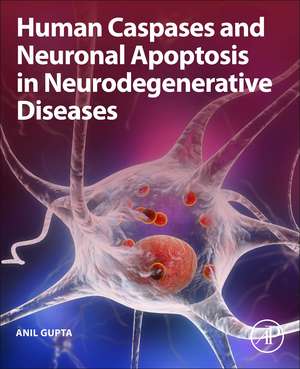Human Caspases and Neuronal Apoptosis in Neurodegenerative Diseases
Autor Anil Guptaen Limba Engleză Paperback – 7 dec 2021
- Provides in-depth knowledge about neurotoxic potential of transition metals, impaired mitochondrial dynamics in the brain neurons, mutant proteins Aβ peptide, tau protein, α-synuclein, huntingtin protein and formation of Lewy bodies, reactive oxygen and nitrogen species, ubiquitin proteasome dysregulation, and many others in neurodegenerative diseases
- Elucidates neurogenetics of gene APP, gene PSEN1, gene APOE, gene LRRK2, gene DJ1, and others in the pathology of neurodegenerative diseases
- Explains caspases-mediated neuronal apoptosis in pathogenesis of Alzheimer’s disease covering amyloidogenesis, caspase-activated DNase, rho-associated coiled coil–containing protein kinase 1, mammalian sterile 20-like kinase 1, role of synaptic loss, microglial TREM2 receptor, microglial LRP1 receptor, microglial advanced glycation end-product receptor, astrocytic glial α 7 subtypes of nAChR, NLRP3 inflammasome, P2X purinoreceptors, miRNAs, and many other factors
- Demonstrates the role of caspases and apoptosis in Parkinson’s disease covering truncation of α-synuclein, neuroinflammation, parkin protein, activation of microglial cells, extrinsic and intrinsic pathways of apoptosis, Δtau314, and several other factors
- Explains etiopathogenesis of Huntington’s disease through covering clinically important topics as role of exon 1 HTT protein, ubiquitous nature of huntingtin, length of expanded polyglutamine tract, classically and alternately activated microglia, nuclear factor kappa B, kynurenine signaling pathway, tumor suppressor protein, PGC-1α gene, advanced glycation end-products, autophagy, and many other significant topics
Preț: 316.60 lei
Nou
Puncte Express: 475
Preț estimativ în valută:
60.58€ • 64.78$ • 50.51£
60.58€ • 64.78$ • 50.51£
Carte disponibilă
Livrare economică 28 martie-11 aprilie
Livrare express 13-19 martie pentru 37.74 lei
Preluare comenzi: 021 569.72.76
Specificații
ISBN-13: 9780128201220
ISBN-10: 0128201223
Pagini: 242
Dimensiuni: 191 x 235 x 15 mm
Greutate: 0.51 kg
Editura: ELSEVIER SCIENCE
ISBN-10: 0128201223
Pagini: 242
Dimensiuni: 191 x 235 x 15 mm
Greutate: 0.51 kg
Editura: ELSEVIER SCIENCE
Public țintă
Biomedical researchers, graduate students, and scientists, as well as neuroscientist and student traineesCuprins
1. Neurodegenerative Diseases: Neuropathology, Genetics, and Epidemiology
2. Role of Caspases, Apoptosis and Additional Factors in Pathology of Alzheimer’s disease
3. Role of Caspases and Apoptosis in Parkinson’s disease
4. Illustrated Etiopathogenesis of Huntington’s Disease
2. Role of Caspases, Apoptosis and Additional Factors in Pathology of Alzheimer’s disease
3. Role of Caspases and Apoptosis in Parkinson’s disease
4. Illustrated Etiopathogenesis of Huntington’s Disease
